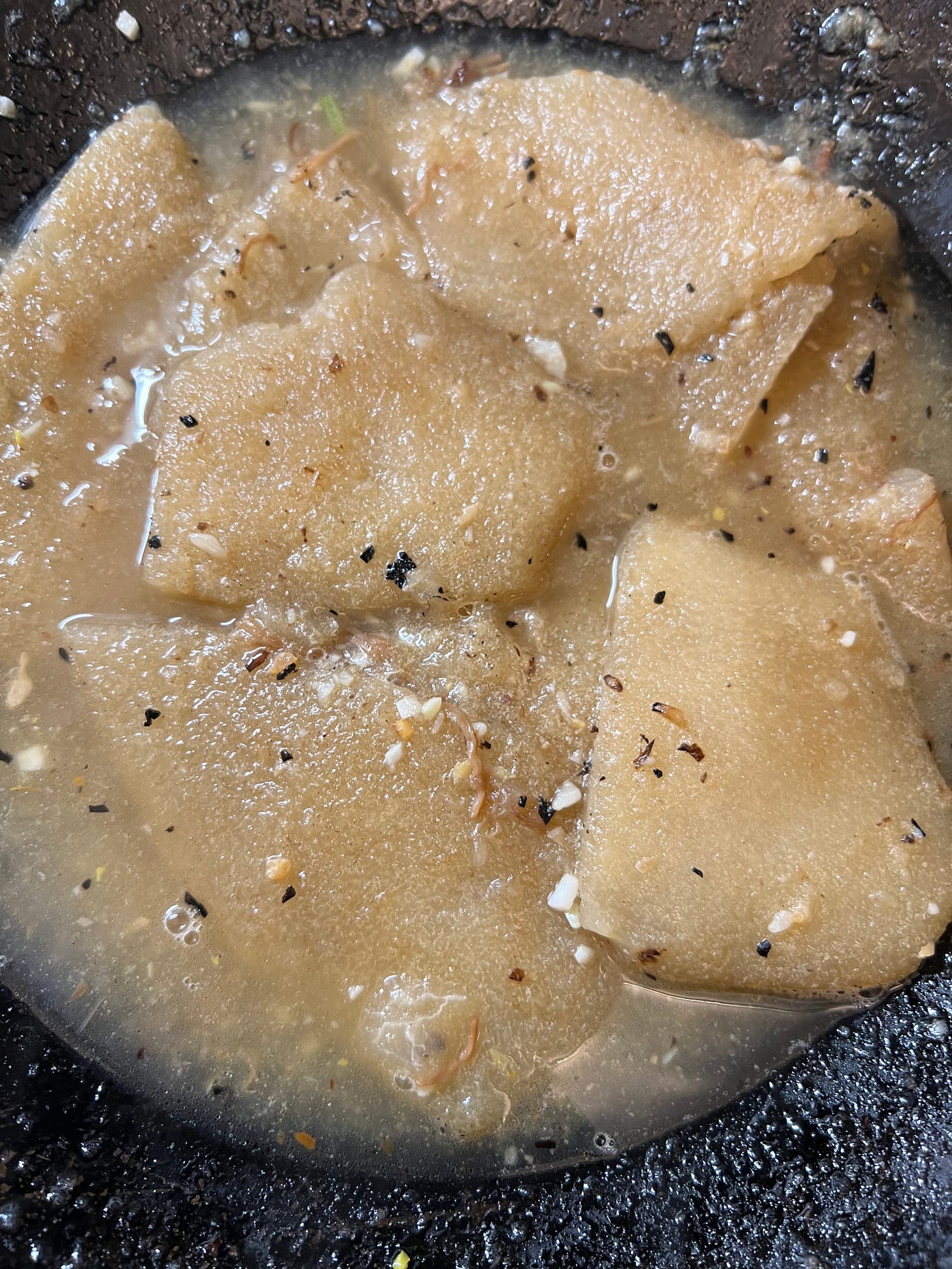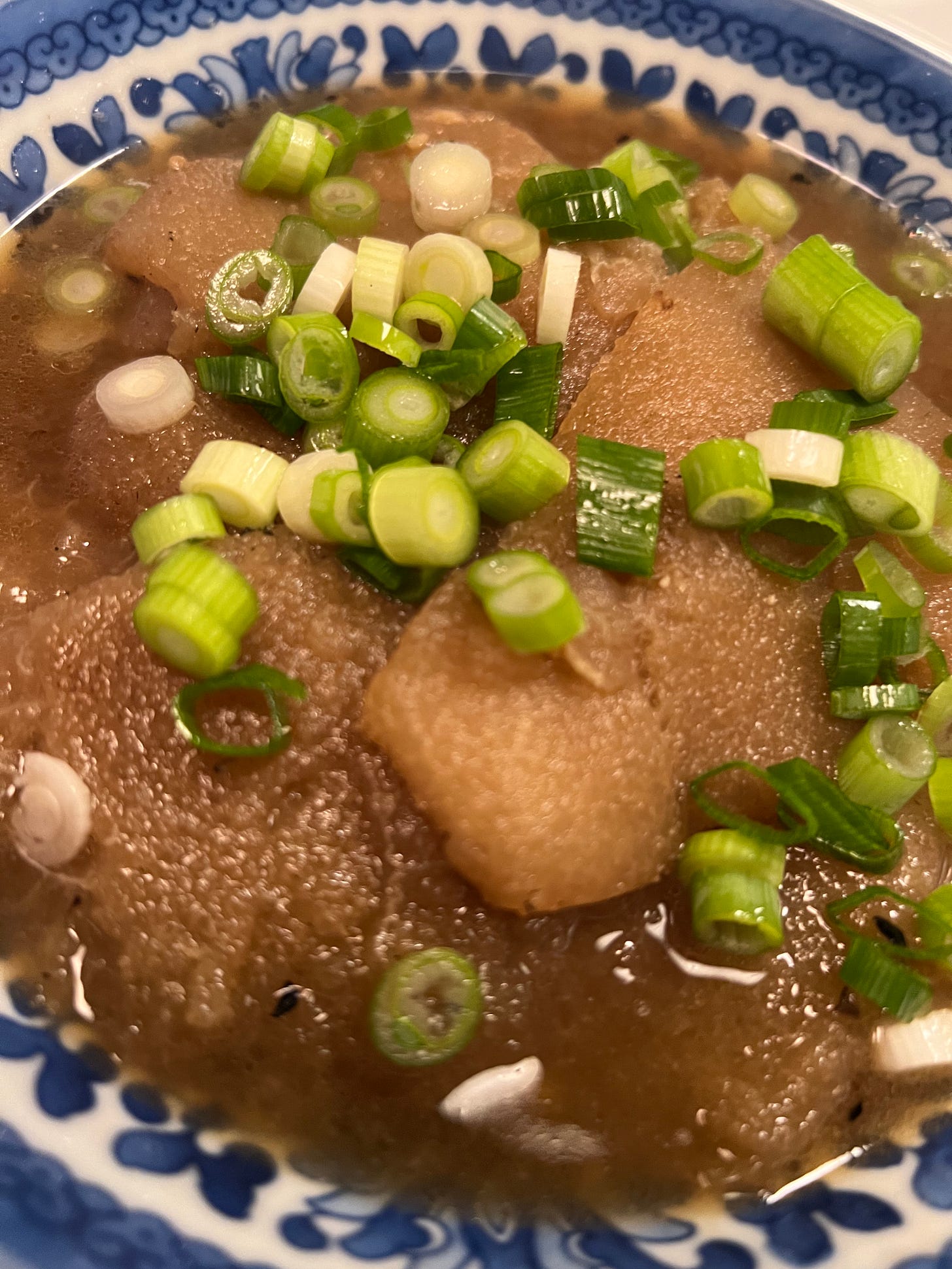Fruits of My Labor: a Podcast and a Pomelo
What’s Burning? Announcing My New Podcast, The OG Citrus, and A Perennial Favorite Pomelo Salad
Welcome to issue #35, in which I give you some advice on what to do with a pomelo, which you should be seeing in markets at this time of year. But before we get to that, I have an announcement to make. Yesterday was the launch of my new podcast, What’s Burning, an ongoing series of interviews with experts from across the food industry and around the world about how we might reimagine culinary education to account for the ever-changing global landscape of gastronomy. Intended for both amateurs and professionals, culinary students and food lovers, alike, the series explores trends in food politics, sustainability, social and racial justice, education, farming, cooking, and cuisines. You’ll hear from chefs from around the world, such as Gaggan Anand, Dominque Crenn, Dan Barber, and Michael Elégbédé, as well as other experts, such as Danny Meyer, Jamila Robinson, Nicolas Chatenier. New episodes will drop every other Wednesday, wherever you listen to podcasts. What’s Burning is produced by the Galilee Culinary Institute by JNF USA, a new school set to open in the north of Israel in 2023. Listen, learn more here.
If I lived in Thailand, I would eat my weight in fruit every day. The few times I’ve been there for any length of time, I’ve come pretty close. I love how on almost every corner street vendors sell perfectly ripe, ready-to-eat fruit in small bags with wooden picks to facilitate munching on the go. I love how the entrances to grocery stores overflow with fruit, available whole, prepped to consume, dried, and juiced. I take all the beverages out of my hotel refrigerators so I can fill them with bags and trays of fruit.
In this fantasy, when I’m not eating fruit, I’m eating salads. Thai salads are some of the brightest, most flavorful, most texturally complex salads on the planet. They shift the paradigm of what might even be considered a salad. Sure, everyone knows som tum, the green papaya salad. But there are so many others, made from crispy fried watercress, chilled seafood, grilled pork, shredded fried fish, and the one that brings together my two loves, pomelo salad. That’s right, a fruit salad that isn’t a “fruit salad,” but a savory combination of crunchy goodness.
Pomelos make me smile. They look like misshapen, oversized grapefruits that are almost too big to be taken seriously. In fact, they are older than grapefruits, older than oranges, too, for that matter. The genealogy of citrus begins in China with pomelos, mandarins, and citrons, from which most other citrus derive. I was always intimidated by pomelos, daunted by their thick pith and turgid corpuscles, until I visited Thailand for the first time and came upon trays of oversized, plump suprêmes of white and pink pomelo for sale. They were so easy and so delicious to eat this way. I’ve loved them ever since.
When pomelo season comes, usually around now, I always pick up one or two so I can make my perennial pomelo salad. It’s only slightly more of a production here than it would be in Thailand because you have to clean the pomelo yourself. But this is a small price to pay for a salad that comes out like a burst of sunshine on a dreary winter’s day. I encourage you to give it a try.
RECIPE: Thai Pomelo Salad
(Serves 4 to 8, depending on what else you are serving )
1/4 cup dry roasted, unsalted peanuts
1 large or 2 small pomelos
2 tablespoons (coconut) palm sugar or light brown sugar
1 tablespoon water
1 or 2 red Thai chiles, seeded and finely chopped, to taste
1 large clove garlic, very finely minced
1/4 cup fresh lime juice (from. about 1 to 1 ½ limes)
3 tablespoons Thai fish sauce
Pinch salt
3/4 cup cilantro leaves and tender stems
2 cups finely sliced Napa or Chinese cabbage, bok choy, other greens, or a combination
2 tablespoons tiny dried shrimp, whole or chopped, as you prefer
Crispy fried shallots, store-bought or homemade, for garnish (optional)
Even though they are already “dry roasted,” toast the peanuts for about 10 minutes in a 300°F. oven to enliven them. Chop coarsely and set aside.
While the nuts are toasting, tackle the pomelo. I find it easiest to cut the whole thing into quarters and then peel off the skin and as much of pith as comes with it. You will have inevitably cut open some sections when you quartered it. Working over a large bowl, pull the corpuscles out of the membrane of each section, working one at a time. Some will fall right out in nice big chunks. Others will be more stubborn. They are affixed along a membranous line at the bottom, that is, the wide end, of the section. Work carefully here to pull the corpuscles off the membrane without bursting them. Ideally, you don’t want to see any membrane in your bowl and you want to try to keep the chunks as big as you can. But don’t worry too much about any of this.
In a small bowl, make the dressing by whisking together the palm sugar and the water to dissolve. Add the chilies, garlic, lime juice, fish sauce, and salt, to taste. Adjust the seasoning to balance the flavors, as desired. To the bowl with the pomelo, add all but 1 tablespoon of the chopped peanuts, all but 1 tablespoon of the cilantro, the Napa cabbage and/or other greens, and the dried shrimp. (The shrimp are traditionally left whole, but Nate does like to see them, so I chop them finely, which distributes their flavor.) Pour the dressing in with the other ingredients and toss well to evenly distribute and dress. Transfer to a serving dish and top with the reserved tablespoon of chopped peanuts, the reserved cilantro, and the crispy shallots, if using.
You can prepare all of the components of this salad up to a day or even two in advance, keeping them separate and refrigerated. Do not combine them until just before serving. The salad is fine to keep as leftovers for a day or two after it is tossed, but it wilts and throws off quite a bit of liquid. Also, the peanuts reconstitute in the liquid in a way that reminds you that they are actually legumes.
For a variation, you could add cooked seafood, shrimp and/or squid, to this salad.
Pomelo, Extreme Waste-Not Edition
Last year, while looking at something totally unrelated—that’s usually how you find the best videos online, isn’t it? —I came across this how-to video for an intriguing
Cantonese pomelo dish on one of my favorite YouTube channels, Chinese Cooking Demystified. Unusually, the focus of the dish is on the rind, not the fruit. After an elaborate preparation that includes burning the rind over an open flame, scraping off the charred skin, rinsing and squeezing what’s left eight times in eight changes of water, then blanching it, rinsing and squeezing it again, you braise it in an umami-rich seafood broth that you finish with dried shrimp roe and thicken with a cornstarch slurry.
I found so much to appreciate about this dish. I admire the methodical transformation of what is ostensibly trash into the main ingredient of a dish. All that effort says to me this is a very old dish from a time maybe when we didn’t always have enough to eat and we had to find a way to eat whatever we had. I love the tradition and the true, waste-not nature of the whole thing.
I had to make it.
When pomelo season came last year, I purchased two smallish ones to make the pomelo salad and then to try my hand at this Cantonese specialty. But the pomelos I bought, grown domestically, had almost no pith and very thin skin. There was nothing to burn, I tried but was foiled. This year, while shopping at our local Asian market in Ithaca, Ren’s, I spotted a large, pristine pomelo imported from China. It was pricey, but here was my chance. I brought it home.
The fruit of this pomelo was so large I was able to make two salads from it, not one. And the rind was almost an inch thick. I watched the video, took notes, and did exactly what Papa Li did. Almost. I had some shrimp stock on hand, so I used that. And I enhanced the umami with some powdered dried shrimp and some of my homemade XO sauce. I will say the pomelo rind turns into a kind of sponge that soaks up the braising liquid. It reminded me of a gourd, almost like loofah, and with the braise it had an intense umami sea taste. I could see using differently flavored broths to cook it depending on the desired effect. To be honest, I’m not sure I will make this again, but I’m really glad I did it this one time. And I think there may be a whole genre of seed-to-skin chefs might explore. Here's the process I undertook the other night in a series of images.












